Detailed explanation of 112 commonly used deciduous trees, definitely worth a look!
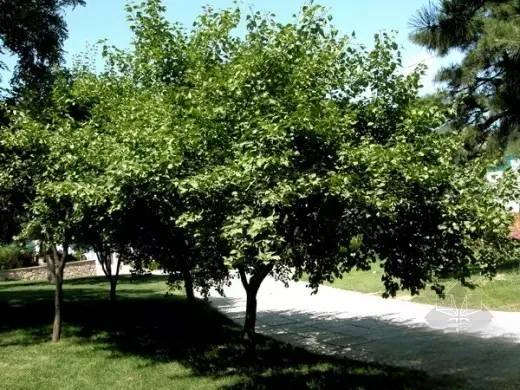
Prunus armeniaca, Rosaceae
Scientific Name : Siberian Apricot
Identification points : Deciduous shrub or small tree, 2-5m tall. Branches are gray-brown or reddish-brown, hairless. Flowering period is March to April, and fruiting period is June to July.
Ecological habits: Strong resistance to low temperature. Developed root system, drought resistance, barrenness resistance, salinity resistance, and waterlogging resistance.
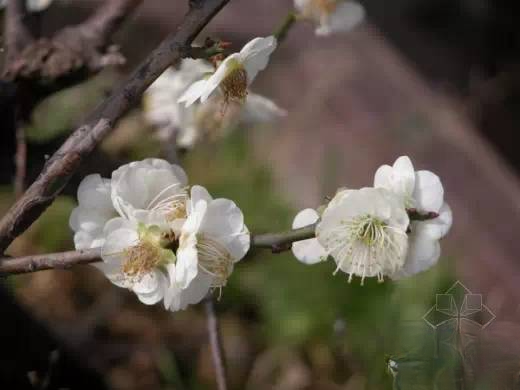
Plum, Rosaceae, Prunus
Scientific Name: Prunus mume
Identification points: Deciduous tree. Many branches. Single leaves are alternate, with petioles and glands at the base of the leaves. There are 2 linear stipules at the base of the petioles of young branches. The leaves are ovate to oblong, with long tails at the tips and broad cuneate bases. The edges have fine and sharp serrated teeth, and the backs of the veins are brownish yellow. The flowering period is January-February, and the fruiting period is May.
Garden use: Plum blossoms are best planted in courtyards, lawns, low hills and mountains. They can be planted alone, in clusters or in groups. They can also be potted for viewing, trimmed and made into various piles, or cut into vases for indoor decoration.
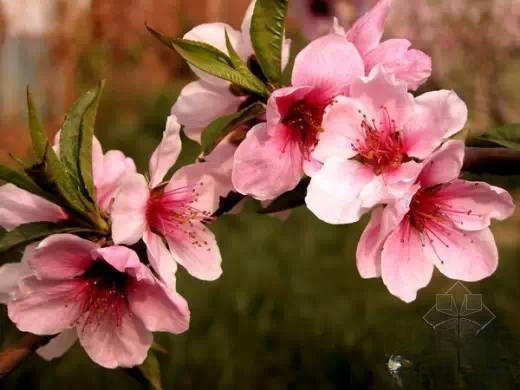
Peach, Rosaceae
Scientific name: Amygdalus persica Linn
Identification points: Deciduous small tree, up to 8 meters tall, with spreading crown. Branches reddish brown or brownish green. Single leaves alternate, elliptical lanceolate, with long pointed tips and coarse serrations on the edges. Flowering period March to April, solitary, sessile, usually pink, single petal. Fruit matures from June to September, drupe ovoid, with short soft hairs on the surface.
Ecological habits: light-loving, drought-resistant and cold-resistant.
Garden use: Peach is a small deciduous tree whose fruit is grown as a fruit. The flowers are ornamental and the fruit is juicy. It can be eaten raw or made into peach preserves, canned food, etc. The kernel is also edible.
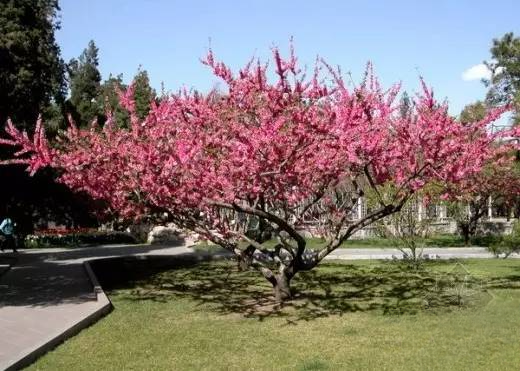
Peach, Rosaceae, Prunus
Scientific name: Prunus persica Batsch. var. duplex Rehd.
Identification points: Deciduous small tree, up to 8 meters high, usually controlled to 3-4 meters after shaping, reddish brown twigs, hairless; elliptical lanceolate leaves, 7-15 cm long, gradually pointed at the tip. Flowers are solitary or two in the leaf axils, double petals, pink. Other variants include white, dark red, gold (variegated), etc.
Ecological habits: It likes light, is drought-resistant and cold-resistant, and requires fertile soil with good drainage. During the growth period, it requires good management, fertilization, irrigation, weeding, and pest control.
Garden use: The flowers of the peach tree are large and colorful, and they are beautiful when they bloom. The viewing period is as long as 15 days. In landscaping, it is widely used in lakeside, streams, both sides of roads and parks, etc. In small greening projects such as: courtyard greening embellishment, private gardens, etc., it is also used for potted viewing, and is also often used for cut flowers and bonsai. Another common one is the weeping peach. The peach tree has a wide range of uses in landscaping, and the greening effect is outstanding. It has a particularly good effect in the year of planting. It can be planted in rows, in groups, or alone, and it has a particularly good greening effect in the year.
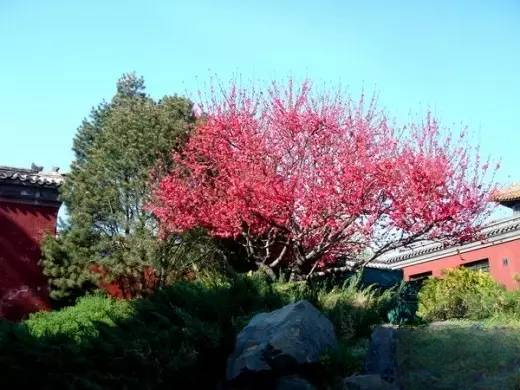
Purple-leaved peach, Rosaceae, Prunus
Scientific name: Amygdalus persica f. atropurpurea
Identification points: Deciduous small tree, plant height 3-5m, bark gray-brown. Single leaves are alternate, ovate-lanceolate, young leaves are bright red, flowers are double, pink, drupes are spherical, and the fruit skin has short hairs. Flowering period is March-April, and the fruit matures in June-September.
Ecological habits: It likes light, is drought-resistant and cold-resistant, and requires fertile soil with good drainage. During the growth period, it requires good management, fertilization, irrigation, weeding, and pest control.
Garden use: With the continuous improvement of the level of garden greening, the requirements for the quality of seedlings are also increasing. Purple-leaf peach, with its unique advantage of purple color, has been widely used in garden greening by garden greening companies all over the country.
Longevity peach, Rosaceae, Prunus
Scientific Name: Var.densa Makino
Identification points: Deciduous small tree, a variant of the common peach. The plant is short, with short internodes and dense flower buds. The flowering period starts in April and lasts for about half a month. The fruit matures in September.
Ecological habits: It likes sunshine and well-drained soil, is drought-resistant and relatively cold-resistant, and can overwinter at above one degree Celsius.
Garden use: With the continuous improvement of the level of garden greening, the requirements for the quality of seedlings are also increasing. In garden greening, it has been widely used by garden greening companies in various places.
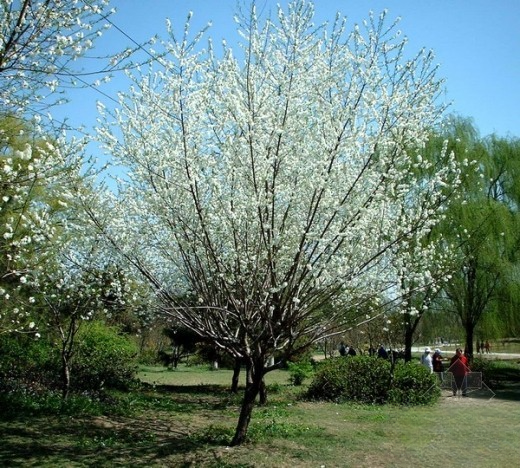
Peach
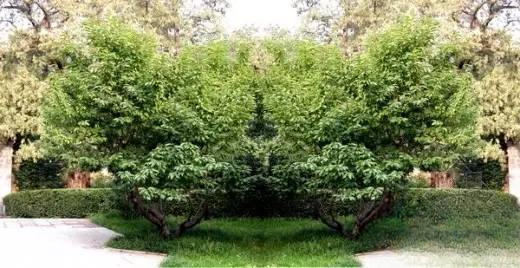
Cherry, Rosaceae, Prunus
Scientific Name : Prunus pseudocerasus
Identification points: Deciduous shrub. Plant height can reach 8m, young branches are glabrous or slightly hairy. Leaves are ovate to ovate-elliptical, 7-16cm long, 4-8cm wide, gradually pointed at the tip, rounded at the base, with serrations of varying sizes on the margins, glands on the serrations, glabrous or slightly hairy on the upper surface, and sparsely hairy on the lower surface. Flowering period is March to April. Fruiting period is May.
Ecological habits: like warmth and light, grow in sunny places on hillsides or by ditches, suitable for cultivation at an altitude of 300-600m and around 33-39° north latitude. Afraid of waterlogging and drought, big cherry avoids wind and frost, and is suitable for an annual average temperature of 10-13℃ or above.
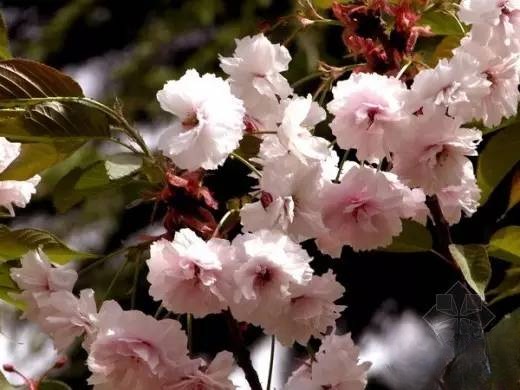
Sakura, Rosaceae, Prunus
Scientific Name: Prunus serrulata
Identification points: Deciduous tree. About 5-25 meters tall. Bark dark chestnut brown, smooth and shiny, with horizontal stripes. Branches glabrous. Leaves ovate to ovate-elliptical, with awns and semi-mature teeth on the edges, glabrous on both sides. Flowering period March-May. Ridge fruit spherical, black, ripening in July.
Ecological habits : It likes sunshine, warm and humid climate environment, and is not strict with soil. It grows best in deep and fertile sandy soil. It has shallow roots and is weak in resistance to smoke, harmful gases and sea tides. It is not resistant to saline-alkali soil. The root system is shallow and avoids low-lying areas with stagnant water. It has a certain degree of cold and drought resistance, but is weak in resistance to smoke and wind.
Garden use: Cherry blossoms are bright and colorful, with luxuriant branches and leaves. They are an important ornamental tree species in early spring and are widely used for gardening. Cherry blossoms can be planted in groups to form forests, or on hillsides, courtyards, roadsides, and in front of buildings. When in full bloom, the flowers are numerous and gorgeous, covering the entire tree, like clouds and rosy clouds, which is extremely spectacular. They can be planted in large areas to create a "sea of flowers" landscape, or in groups of three or five to embellish the green space to form a colorful group, or they can be planted alone to create a "red dot in the green" painting idea. Cherry blossoms can also be used as roadside trees, hedges, or bonsai.
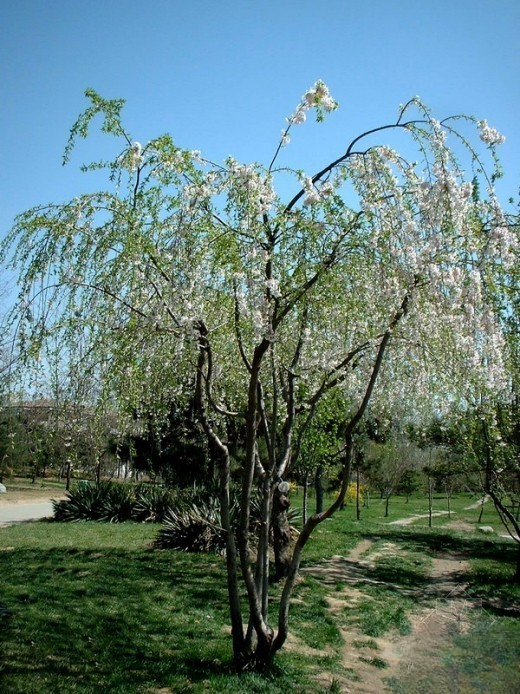
Weeping cherry, Rosaceae, Prunus
Scientific name: Prunus subhirtella var. pendula Tanaka
Identification points: Deciduous tree. The crown is ovate to round, the leaves are alternate and glandular, the flowers are solitary at the top of the branches or in clusters of 3-6 in umbel or corymbose inflorescences, growing at the same time as the leaves or before the leaves, the calyx tube is bell-shaped or tubular, and most cultivated varieties are double-petaled; the fruit is red or black, and matures in May-June.
Ecological habits: It likes sunlight and a warm and humid climate environment. It is not very demanding on soil and grows best in deep, fertile sandy loam. It has shallow roots and is weak in resistance to smoke and wind.
Garden use: Cherry blossoms are extremely beautiful. When in full bloom, the trees are full of flowers, like clouds and rosy clouds. It is a famous ornamental flower that blooms in early spring.
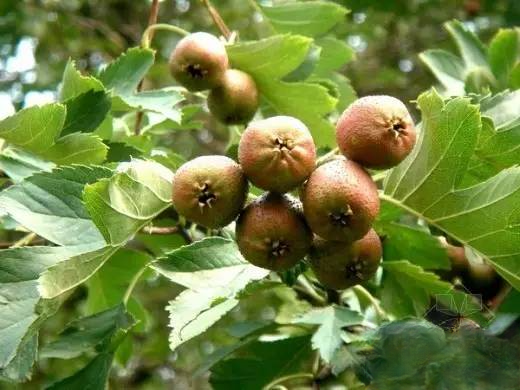
Hawthorn, Rosaceae, Crataegus
Scientific Name: Crataegus pinnatifida
Identification points: Deciduous tree. Dense branches with fine thorns, young branches with soft hairs. Branchlets are purple-brown, old branches are gray-brown. Leaves are triangular-ovate to prismatic-ovate. Flowering period is May to June, and fruiting period is September to October.
Ecological habits: Generally grows in valleys or mountain bushes, has strong adaptability and super flood resistance.
Garden use: The tree has a neat crown, lush branches and leaves, is easy to cultivate, has few diseases and pests, and has delicious flowers and fruits. Therefore, it is also a good ornamental tree species for greening fields and gardens.
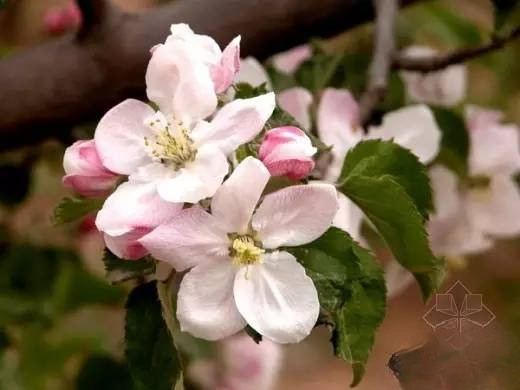
Apple, Rosaceae, Malus
Scientific Name: Malus domestica
Identification points: Deciduous tree. Up to 15m tall, with gray-brown trunk, old bark with irregular longitudinal cracks or flaking, twigs densely covered with velvet when young, then smooth and purple-brown. Single leaves alternate in the phyllotaxy. Flowering period: April to June; fruiting period: July to November.
Ecological habits: It likes light and slightly acidic to neutral soil. It is most suitable for deep soil layer, rich in organic matter, and sandy soil with good ventilation and drainage.
Garden use: There are four varieties of apples, all of which are very graceful and have their own characteristics and high ornamental value.
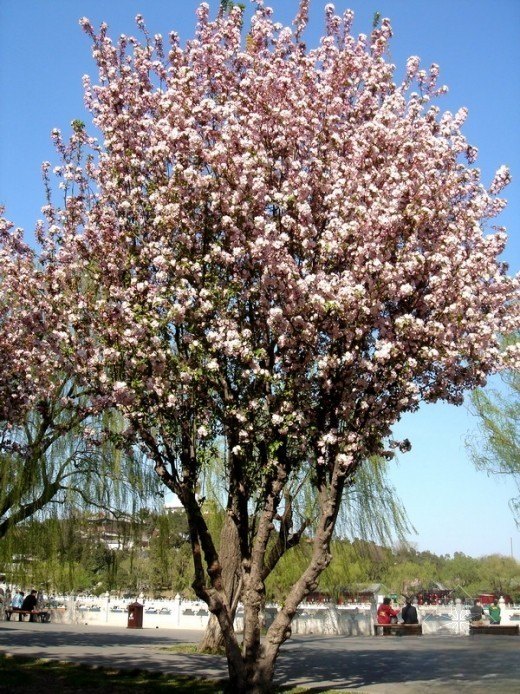
Begonia, Rosaceae, Malus
Scientific name: Malus spectabilis
Identification points: Deciduous tree, up to 8 meters tall; twigs cylindrical, erect, reddish brown with short soft hairs when young, dark brown and hairless when old; leaves elliptical to oblong, flowering from April to May, fruiting in September.
Ecological habits: It likes sunny, fertile and humid environment, is cold-resistant, and is afraid of drought and waterlogging; it is not picky about soil, but if there is too much fertilizer and water, the plant will easily grow too tall and the number of flower branches will decrease, affecting its ornamental value.
Garden use: The flowers of the weeping crabapple are bright in color and graceful in shape. They have a faint fragrance when they first bloom. The leaves are ovate or oval. The flowers grow in clusters at the top. The petals are rose red, and they bend and droop. When the breeze blows, they are delicate and bright red. From a distance, they look like dense red clouds, which is beautiful. It is a popular garden woody flower.
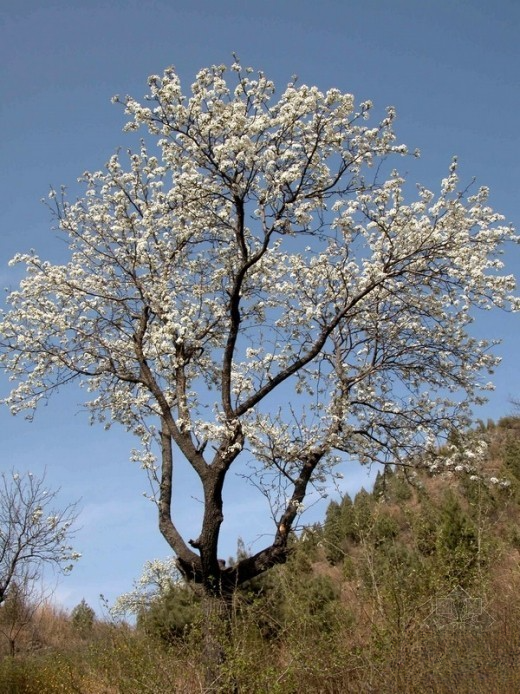
White pear, Rosaceae, Pyrus
Scientific Name: Pyrus spp
Identification points : Deciduous tree. Up to 5-8m tall. Spreading crown; twigs are sturdy and pubescent when young; biennial branches are purple-brown with sparse lenticels. Petiole 2.5-7cm long; stipules are membranous with glandular teeth on the margins; leaves are ovate or elliptical. Flowering period is April, and fruiting period is August-September.
Ecological habits : cold-resistant, drought-resistant, waterlogged-resistant, and salt-alkali-resistant. In areas where the lowest temperature in winter is above -25 degrees, most varieties can safely overwinter.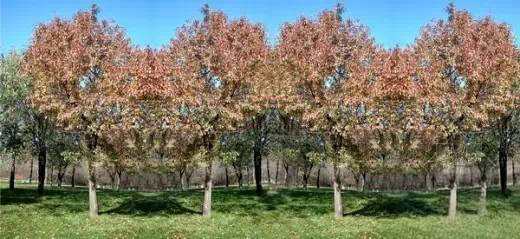
Pyrus betulata, Rosaceae
Scientific name: Pyrus betulifolia Bge.
Identification points : Deciduous tree. Up to 10 meters tall, with spreading crown and branches often with thorns; young twigs are densely covered with grayish white hairs, biennial branches are sparsely covered with hairs or nearly hairless, purple-brown; winter buds are ovate, with gradually pointed tips and covered with grayish white hairs. Leaves are rhombus-ovate to oblong-ovate. Flowering period is April, and fruiting period is August-September.
Ecological habits : It has strong adaptability, likes light, is cold-resistant, drought-resistant, waterlogged and barren-resistant. It can grow normally in neutral soil and saline-alkali soil. The soil salt content in the author's area is 0.4% and the pH value is 8.5, but without technical measures such as soil improvement and soil addition, the planted pears can grow vigorously.
Garden use : Not only is it strong, it is also not very demanding on water and fertilizer. In addition, it has a beautiful tree shape and white flowers. It is widely used in saline-alkali areas in the north. It can be used not only as a shelter forest and soil and water conservation forest, but also for greening streets, courtyards and parks. It is a good tree species worth promoting. The fruit and bark can be used for medicinal purposes. It can be used as a rootstock for pears.
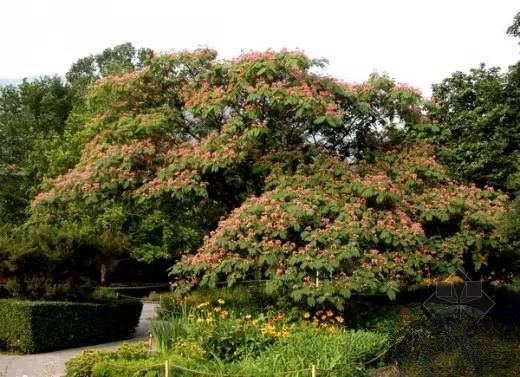
Albizzia julibrissin, Fabaceae
Scientific Name : Albizia julibrissin
Identification points : deciduous tree. Grey bark, even-pinnate compound leaves, opposite leaflets, open during the day and closed at night. Yellow-green calyx and petals, pink filaments, flat pods.
Ecological habits : It likes warm, humid and sunny environment, has strong adaptability to climate and soil, and can grow in well-drained, fertile soil, but is also resistant to poor soil and drought.
Garden use : The tree has a beautiful shape and elegant leaves. In midsummer, the tree is covered with velvet flowers, which are colorful and fragrant, creating a soft and comfortable atmosphere. It is suitable for garden shade trees and street trees, and can be planted at the edge of the forest, in front of the house, on the lawn, on the hillside, etc. It is an ornamental tree for street trees, garden shade trees, greening around the four sides and garden embellishment.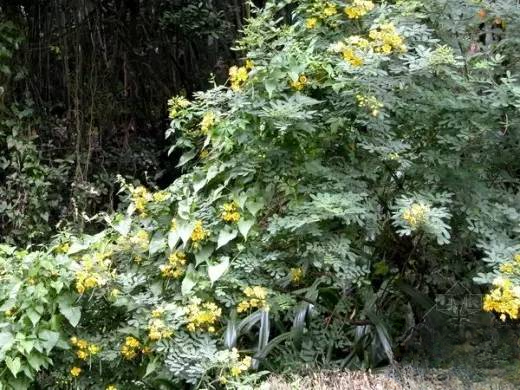
Sophora japonica, Cassia spp., Leguminosae
Scientific name : Cassia surattensis Burm. f.
Identification points : Deciduous tree. 5-7 meters high. Even-pinnate compound leaves; 2-3 club-shaped glands on the petiole and the rachis between the lowest 2-3 pairs of leaflets; 14-18 leaflets, oblong or ovate, pods are strip-shaped, 7-10 cm long and 0.8-1.2 cm wide. The seeds are slightly constricted and have a beak at the tip. Flowers and fruits are produced all year round.
Ecological habits : It likes high temperature, high humidity and light, but is not cold-resistant. It is susceptible to frost damage at 2℃~5℃, and can overwinter in the northern part of southern China in normal years. It is not very demanding on soil, and sandy loam is the best. It tolerates soil drought and waterlogging, and likes fertilizer.
Garden use : It has dense branches and leaves, beautiful tree posture, long flowering period, bright golden color, and tropical characteristics. It is a beautiful ornamental tree, garden tree and street tree.
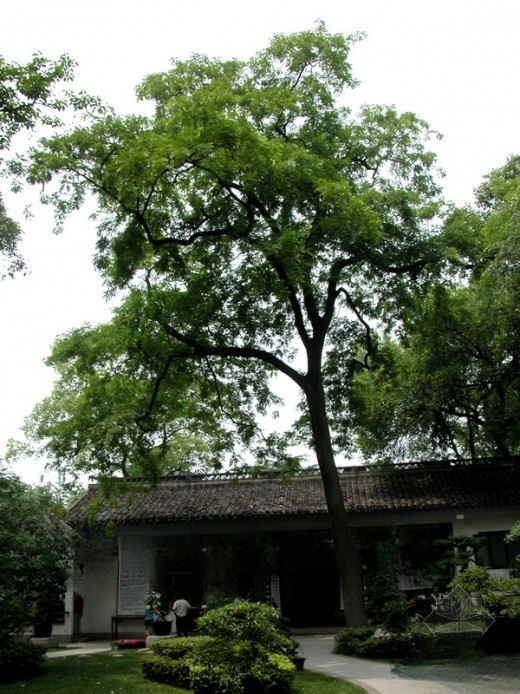
Gleditsia sinensis, Leguminosae
Scientific name : Gleditsia sinensis Lam.
Identification points: Deciduous tree. Up to 30 meters tall; branches gray to dark brown; thorns thick, cylindrical, often branched, mostly conical, up to 16 cm long. Leaves are pinnate. Flowering period March-May; fruiting period May-December.
Ecological habits : It likes light and is slightly shade-tolerant. It likes warm and humid climate and deep, fertile and appropriately moist soil, but it is not very demanding on soil and can grow normally in limestone, saline-alkali and even clay or sandy soil.
Garden use: The soapberry has a large crown and thick shade, and has a long life span. It is very suitable as a shade tree for gardens and greening trees. In addition, the soapberry fruit is rich in saponin, so it can be boiled to replace soap; the seeds can be pressed for oil to be used as a lubricant and soap, and it has medicinal effects on ringworm and laxatives; the soapberry thorns and pods can be used as medicine; the leaves and pods can be boiled in water to kill red spiders. The soapberry wood is hard, resistant to corrosion and wear, but it is easy to crack, and the newly cut wood has a strong odor, so it can only be used to make furniture, columns and piles in buildings, and handles on utensils.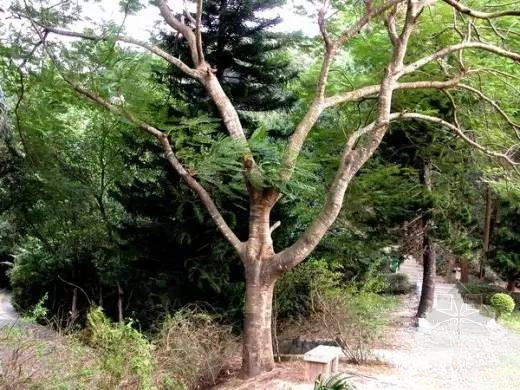
Delonix regia, Fabaceae
Scientific name : Delonix regia (Boj.) Raf.
Identification points : Deciduous tree. 10-20m tall, with a breast diameter of up to 1m. The tree is broad and umbrella-shaped, with many spreading branches. The bark is rough and gray-brown. The twigs are often covered with short hairs and have obvious lenticels. The leaves are alternate and pinnate, and the flowering period is from May to August. The pods are ribbon-shaped or slightly curved and sickle-shaped.
Ecological habits : It likes high temperature, humidity and sunny environment, and the suitable temperature for growth is 20-30℃. It is not cold-resistant, and the winter temperature should not be lower than 5℃. It is suitable for deep, fertile, organic-rich sandy loam; it is afraid of waterlogging, and the drainage must be good. It is relatively drought-resistant and tolerant to barren soil.
Garden use : The crown of the Phoenix tree is tall, and the flowers are red and the leaves are green during the flowering period. The tree is full of fire and magnificent. Because its leaves are like the feathers of a flying phoenix and its flowers are like the crown of a red phoenix, it is named Phoenix tree. It is a famous tropical ornamental tree species.
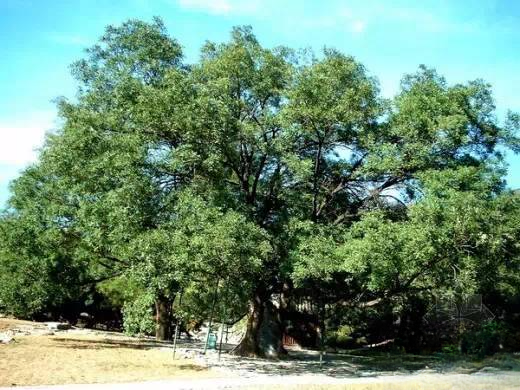
Sophora japonica, Leguminosae
Scientific name : Sophora japonica Linn.
Identification points : Deciduous tree. 6-25 meters tall, dark grey bark, green twigs, obvious lenticels. Pinnate leaves 15-25 cm long. Flowering and fruiting period June-November.
Ecological habits : It is cold-resistant, likes sunlight, is slightly shade-tolerant, cannot tolerate dampness but is drought-resistant. It grows poorly in low-lying waterlogged areas. It has deep roots and is not demanding on soil. It is relatively resistant to barrenness and can grow normally on lime and slightly saline-alkali land (salt content of about 0.15%).
Garden use : a special tree species commonly used in gardens. It has strong fast-growing properties, hard and elastic material, straight texture, easy processing, corrosion resistance, flower buds can be used as dyes, fruit pulp can be used as medicine, seeds can be used as feed, etc. It is also a windbreak and sand fixation, timber and economic forest species, and a good shade tree and roadside tree species in urban and rural areas.
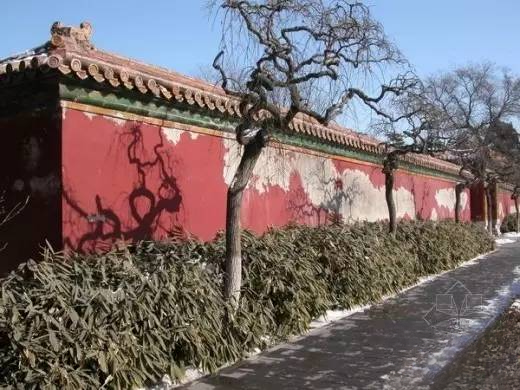
Sophora japonica, Leguminosae
Scientific name : var. pendula Hort.
Identification points : deciduous tree. The twigs are soft and drooping, the crown is like an umbrella, the state is beautiful, the branches form a disk, the upper part is coiled like a dragon, and the old tree is strange and ancient.
Ecological habits : It likes light and is slightly shade-tolerant. It can adapt to dry and cold climates. It likes to grow in deep, moist, fertile, well-drained sandy loam. It has deep roots, a well-developed root system, strong wind resistance, strong germination ability, and a long lifespan.
Garden use : Sophora japonica has a high ornamental value. Since ancient times, it has been planted symmetrically on both sides of temples, halls and other buildings to embellish the garden. During festivals, if colorful lights are hung on the tree, it will look more magnificent. If it is used in a short-stem potted plant, it will make people feel soft and unrestrained. In the flowering season, the beige inflorescence covers the branches, like a yellow umbrella covering the eyes, which is even more beautiful and lovely.
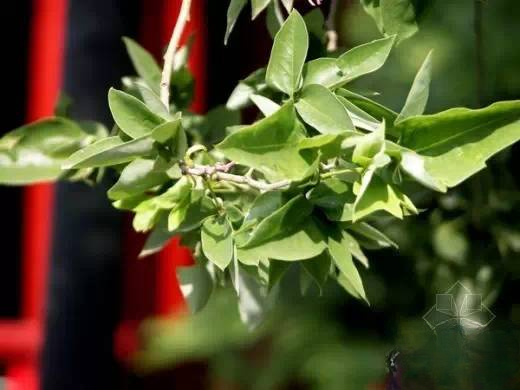
Sophora japonica, Leguminosae
Scientific Name : Sophora japonica f.oligophylla
Identification points: Deciduous tree. This variety has only 1-2 pairs of compound leaves, which are clustered at the tip of the rachis to form a palmate shape, or are only regularly divided into palmate shapes, and are often sparsely covered with long soft hairs on the underside. The leaflets grow in clusters of 3-5, the terminal leaflets are often 3-lobed, and the lower part of the lateral leaflets often has large lobes, and the back of the leaves is hairy.
Ecological habits : It can grow normally on lime, acidic and light saline-alkali soils; it is resistant to smoke and dust, can adapt to urban street environments, and has strong resistance to sulfur dioxide, chlorine and hydrogen chloride. The wood is tough, slightly hard, resistant to water and moisture, and is elastic. It can be used for construction, vehicles, furniture, shipbuilding, farm tools, carving, etc.
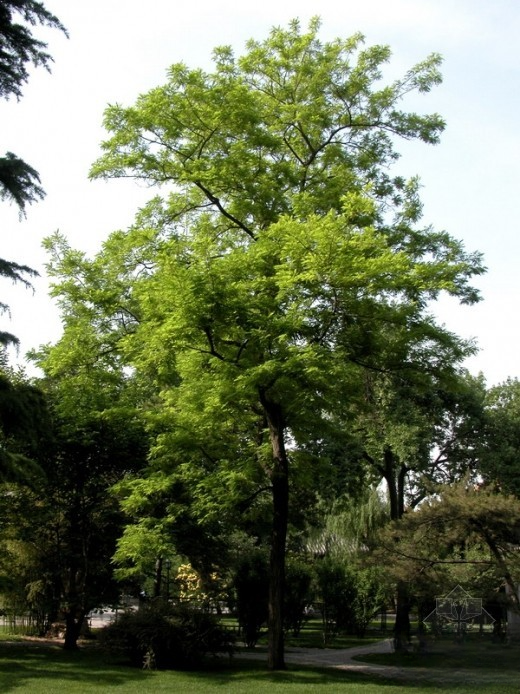
Robinia pseudoacacia, Leguminosae
Scientific Name : Black Locust
Identification points : Deciduous tree. Deciduous tree, 10-20m tall. Bark gray-black brown, longitudinally fissured; branches with stipular thorns, twigs gray-brown, glabrous or pubescent when young. Odd-pinnate compound leaves.
Ecological habits : light-loving tree species, not shade-tolerant. Prefers warm and humid climate, not cold-tolerant.
Garden use: Robinia pseudoacacia has a tall crown and bright green leaves. When it blooms, the green and white complement each other, which is elegant and fragrant. It can be used as a street tree or a shade tree. It is a pioneer tree species for greening industrial and mining areas and barren hills and wastelands. The roots have nodules, which can improve soil fertility. After the leaves fall in winter, the branches are sparse and upward, like silhouettes, and the shape has the charm of Chinese paintings.
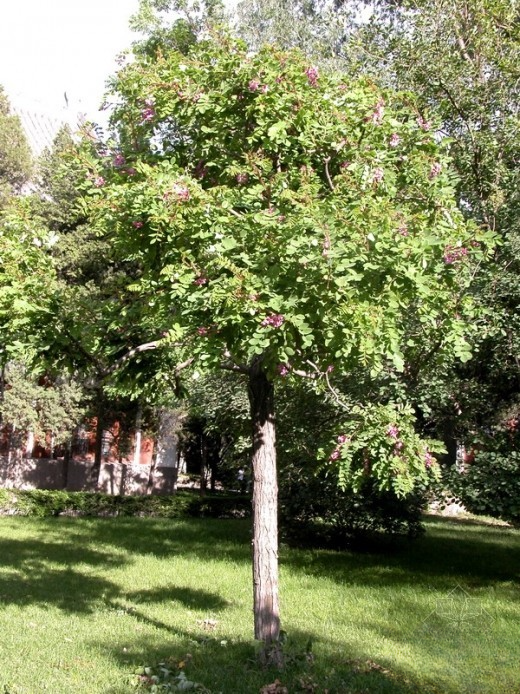
Robinia pseudoacacia, Fabaceae
Scientific name : Robinia hispida L.
Identification points : Deciduous tree. Up to 2-4 meters tall; branches and pedicels densely covered with red spines. Odd-pinnate compound leaves, 7-15 leaflets, nearly round or long, 2-5 meters long.
Ecological habits: light-loving, shallow-rooted, with well-developed lateral roots. Prefers warm, moist and fertile soil.
Garden use: The flowers are rich in color and are suitable for solitary planting, row planting or clump planting. It is a rare ornamental tree species in courtyards, small gardens and parks.
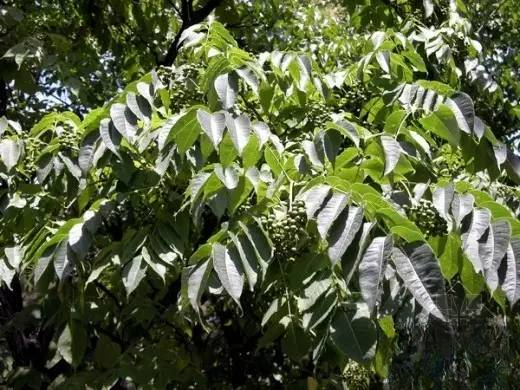
Obaku
Scientific Name : Cortex Phellodendri Chinensis
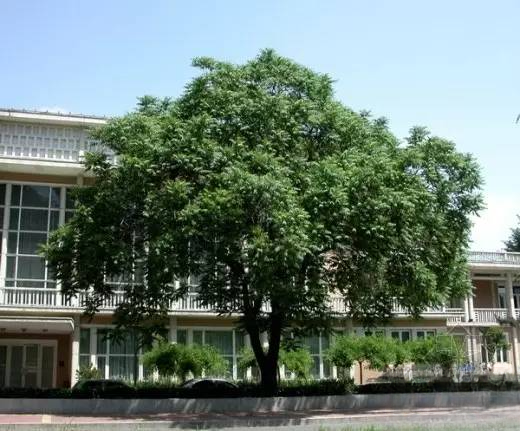
Ailanthus altissima, Ailanthus spp., Simaroubaceae
Scientific name: Ailanthus altissima
Identification points : Deciduous tree. The tree can reach a height of 30 meters, with a breast diameter of more than 1 meter. The crown is flat spherical or umbrella-shaped. The bark is grayish white or grayish black, smooth, with slight shallow cracks. The branches are thick. The twigs are thick. The leaves are odd-pinnate and alternate. Winged fruit.
Ecological habits : It likes light and cannot tolerate shade. It has strong adaptability and can grow in all kinds of soils except clay, neutral, acidic and calcareous soils. It is suitable for deep, fertile and moist sandy soils. It is cold-resistant and drought-resistant, but cannot tolerate water and humidity. Long-term waterlogging will cause root rot and death. It has deep roots.
Garden use : Ailanthus altissima has a straight and tall trunk, purple-red leaves in spring, and red fruits in autumn. It is a good ornamental tree and street tree. It can be planted alone, in groups, or mixed with other tree species. It is suitable for greening factories and mining areas. It is often used as a street tree in India, Britain, France, Germany, Italy, the United States, etc., and is highly praised as the tree of heaven.
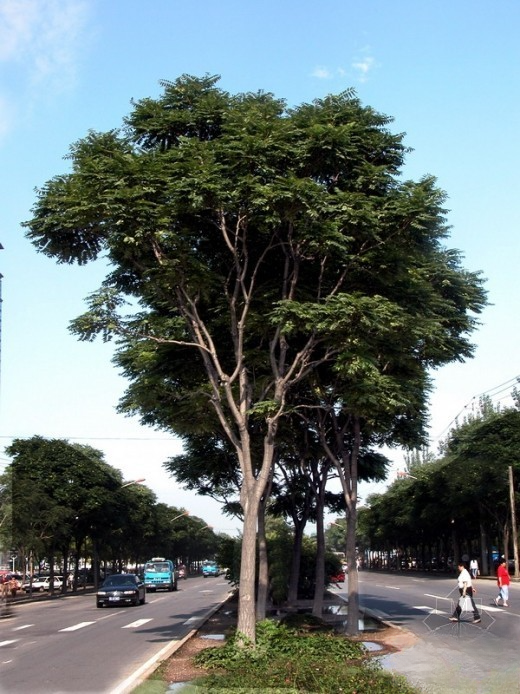
Ailanthus altissima, Simiaceae
Scientific name : Ailanthus altissima
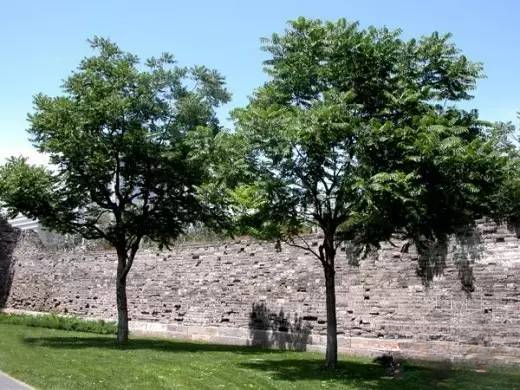
Toona sinensis, Meliaceae
Scientific name : Toona sinensis.A.Juss.
Identification points : Deciduous tree, dioecious, leaves are even-pinnate compound leaves, panicle inflorescence, bisexual flowers are white, fruits are oval capsules, winged seeds, seeds can reproduce. The tree is tall and is not only used for edible toon buds, but also a preferred tree species for landscaping.
Ecological habits : Toona sinensis likes light and is relatively resistant to moisture. It is suitable for growing in fertile and moist soil near rivers and houses, generally sandy loam. The suitable soil pH is 5.5-8.0.
Garden use : Toona sinensis has a straight trunk, a wide crown, dense branches and leaves, and bright red young leaves. It is often used as a shade tree and a street tree. It is placed in sparse forests in gardens as an upper layer of smooth-trunk trees, with shade-tolerant flowers and trees planted below. Toona sinensis is an important timber tree species in low mountains, hills or plains with thick soil in North China, East China, and Central China, and a "four-side" greening tree species.
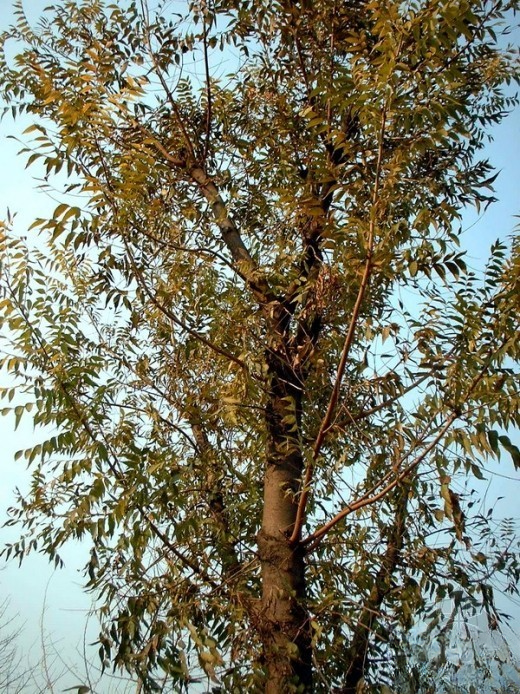
Pistacia chinensis, Anacardiaceae
Scientific name : Pistacia chinensis
Identification points : Dioecious deciduous tree, up to 30m tall, 2m diameter at breast height, nearly spherical crown; thin flaky bark. Usually even-pinnate compound leaves, 10 to 14 leaflets, lanceolate or ovate-lanceolate.
Ecological habits : It likes light and is slightly shade-tolerant when young; it likes warmth and is afraid of severe cold; it is resistant to drought and barrenness and has no strict requirements on soil. It can adapt to slightly acidic, neutral and slightly alkaline sandy and clay soils, and grows best in fertile, moist and well-drained limestone mountains.
Garden use : Pistacia chinensis has a lifespan of several hundred years and is an excellent greening tree species for cities and scenic areas. It has a round crown, lush and beautiful branches and leaves. The young leaves are red in early spring, and turn dark red or orange-yellow in autumn. The red female inflorescence is also very beautiful. It is suitable for garden shade trees, street trees and mountain landscape trees. It is also often used as a "four-side" greening and afforestation tree species in low mountain areas.
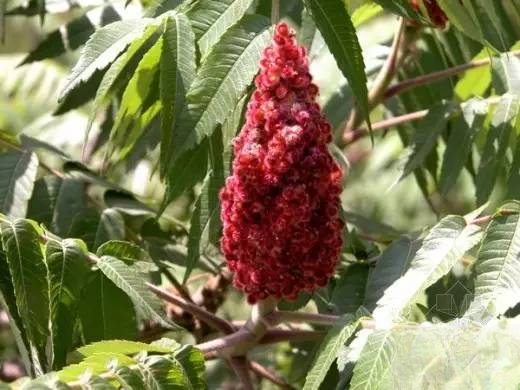
Torch tree, Rhus spp., Anacardiaceae
Scientific Name : Rhus typhina Nutt
Identification points : Deciduous small tree, up to 12m tall. Buds below the petiole. Branchlets densely covered with gray hairs. Odd-pinnate compound leaves, 19-23 (11-31) leaflets, oblong to lanceolate.
Ecological habits: light-loving. Cold-resistant, strong adaptability to soil, drought-resistant, water-resistant, and salt-resistant. Developed root system, strong ability to sprout, 30 to 50 sprouts can be produced in four years. Shallow roots, fast growth, short lifespan.
Garden use : The roots of the torch tree have strong sprouting ability, fast natural reproduction ability, and a high afforestation survival rate. It can still be reborn with its tenacious vitality after human destruction and forest fires.
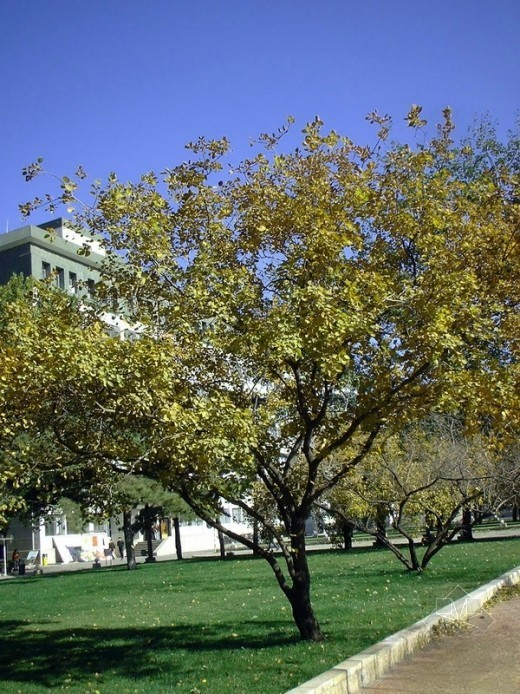
Cotinus coggygria, Anacardiaceae
Scientific Name : Cotinus coggygria
Identification points : Shrub or small tree, 3-5 meters high. Leaves are obovate or ovate, 3-8 cm long, 2.5-6 cm wide, with rounded or slightly convex apex, rounded or broadly cuneate base, entire margin, both sides or especially the back of the leaf are conspicuously covered with gray soft hairs, 6-11 pairs of lateral veins, often forked at the apex; petiole is short
Ecological habits : It likes light and tolerates partial shade; it tolerates cold, drought, barren and alkaline soils, but not water and humidity. It grows best in deep, fertile and well-drained sandy loam.
Garden use : The leaves of Cotinus coggygria turn red in autumn, and the color is bright. The famous red leaves of Beijing Xiangshan are of this species. In fact, in addition to the high ornamental value of the leaves, the lavender feather-like pedicels of Cotinus coggygria are also very beautiful after flowering, and they can stay on the treetops for a long time. When planted in groups, it looks like thousands of silk yarns lingering in the forest from a distance, so it is known as the "smoky tree". In addition, its wood can be used to extract yellow dyes, and can be used to make furniture or for carving.
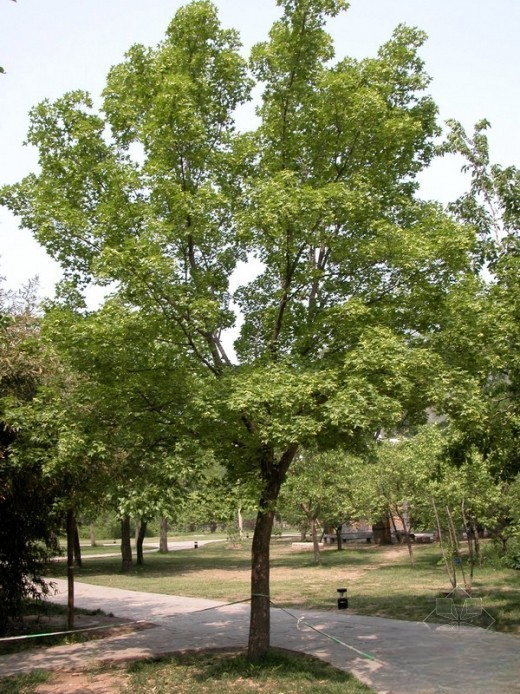
Acer truncatum, Anacardiaceae
Scientific name : Acer truncatum Bunge
Identification points : Deciduous tree, 8-10m tall; bark longitudinally cracked. Single or opposite leaves, 5 main veins, palmate petiole 3-5cm long. Corymbs terminal, yellow-green flowers. Flowering in May, fruiting in September.
Ecological habits : Shade-tolerant, likes warm, cool and humid climate, strong cold resistance, but too dry and cold is not good for growth, also in hot areas. It is not strict with soil requirements, and can grow in acidic soil, neutral soil and calcareous soil, but it grows best in moist, fertile and deep soil.
Garden use: The maple tree has a large crown and dense shade, and has a graceful tree shape and beautiful leaves. Its young leaves are red, and in autumn the leaves turn orange or red. It is an important autumn-colored leaf tree species in the north. It is planted as a garden shade tree and street tree in various provinces in North China. It is elegant when planted on embankments, lakeside, grasslands, and near buildings.
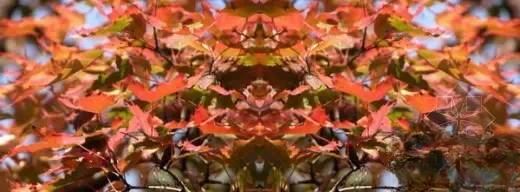
Acer truncatum, Sapindaceae
Scientific Name : Acer ginnala
Identification points : Deciduous shrub or small tree, up to 6m tall. Bark is gray-brown. Young branches are green or purple-brown, and old branches are gray-yellow. Single leaves are opposite, papery, ovate or oblong ovate.
Ecological habits : Tolerant to shade, cold, likes moist soil, but can tolerate dryness and barrenness, strong disease resistance, strong adaptability. It often grows on sunny slopes, river banks or wet grasslands below 800m above sea level, scattered or forming jungles, and is also common on the edge of mixed woods on semi-sunny or semi-shady slopes.
Garden use : The trunk is straight, the flowers are fragrant, the fruit wings are beautiful red in summer, and the leaves easily turn bright red in autumn. The winged fruit is also red and lovely before it matures. It is a good garden ornamental tree species. It can also be planted as a hedge and small street tree, screen, clump planting, group planting, and is shade-tolerant than other maple trees. It has strong sprouting ability and can be potted.

Acer palmatum, Acer genus, Aceraceae
Scientific name : Acer palmatum Thunb.
Identification points : small deciduous tree. Height range 6-7 m, dark grey bark. Small branches are thin and thin; young branches are green and thin. Current year branches are purple or light purple-green; perennial branches are light grey purple or dark purple. Leaves are papery and round in appearance.
Ecological habits : A weak sun-loving tree species that tolerates partial shade. It is easily harmed by sunburn in summer if planted alone in direct sunlight. It likes warm and humid climate and fertile, moist and well-drained soil. It is not very cold-resistant and can adapt to acidic, neutral and calcareous soils.
Garden use : The leaves of the Japanese maple are beautiful, turning bright red in autumn, as bright as flowers and as brilliant as clouds. It is an excellent foliage tree species. No matter where it is planted, it is fascinating. It is very suitable to be planted on lawns, mounds, streams, pools, roadsides, walls, pavilions, corridors, and rocks. It is particularly beautiful if it is set against evergreen trees or white walls. It is also very elegant to make it into bonsai or potted plants for indoor beautification.
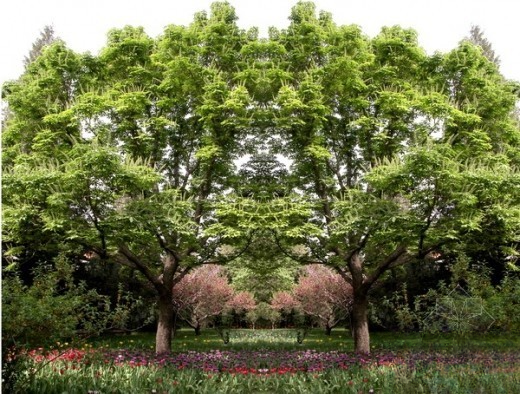
Horse Chestnut, Aesculus genus
Scientific Name : Aesculus
Identification points : Deciduous tree, up to 25 meters high, with dark brown or gray-brown bark, cylindrical twigs, yellowish brown or gray-brown, glabrous or slightly pubescent when young, with round or oval yellowish lenticels.
Ecological habits : likes light, slightly shade-tolerant; likes warm climate, can also tolerate cold; likes deep, fertile, moist and well-drained soil. Deep roots, strong germination ability; medium to slow growth rate, long lifespan.
Garden use : Horse chestnut has a beautiful tree shape, large and beautiful flowers, and peculiar fruit shape. It is a rare tree species for viewing leaves, flowers, and fruits, and is one of the world's famous ornamental trees. In China, horse chestnut has a deep connection with Buddhism, so many ancient temples such as Lingyin Temple in Hangzhou, Reclining Buddha Temple in Beijing, and Dajue Temple have horse chestnut trees that are more than a thousand years old.
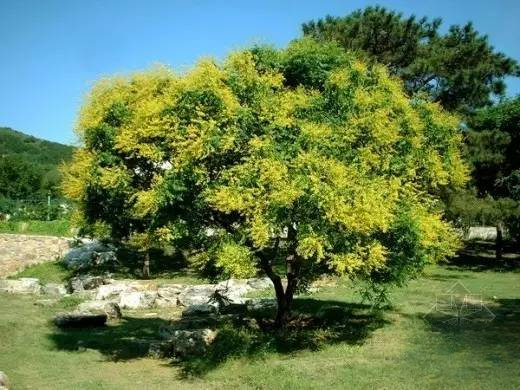
Koelreuteria paniculata, Sapindaceae
Scientific Name : Koelreuteria paniculata
Identification points: Deciduous tree, up to 20 meters high, with gray-brown bark and fine longitudinal fissures; twigs are slightly angular, without terminal buds, with obvious lenticels, and a nearly spherical crown with a crown width of 8-12 meters, and odd-pinnate compound leaves arranged alternately.
Ecological habits : It likes light and can tolerate partial shade; it is cold-resistant; but not resistant to waterlogging. Pay attention to the land when planting. It is resistant to drought and barrenness, has strong adaptability to the environment, likes to grow in calcareous soil, and is resistant to salinity and short-term waterlogging.
Garden use: Koelreuteria paniculata is also known as the doctor tree and lantern tree. It is a species of the genus Koelreuteria in the Sapindaceae family. Koelreuteria paniculata is a deciduous tree with a neat shape and lush and beautiful branches and leaves. In spring, the young leaves are mostly red. In summer, the tree is full of yellow flowers. In autumn, the leaves turn yellow and the fruits are purple-red, shaped like lanterns, which is very beautiful. Koelreuteria paniculata has strong adaptability and obvious seasonal phases. It is an ideal greening and foliage-viewing tree. It is suitable for garden shade trees, street trees and landscape trees. In addition, tannin can be extracted, the flowers can be used as yellow dyes, and the seeds can be used to extract oil. Koelreuteria paniculata is also a good tree species for industrial pollution areas.
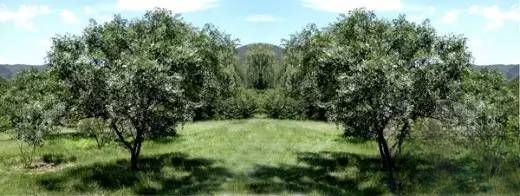
Xanthoceras sorbifolia, Sapindaceae Xanthoceras genus
学名:Xanthoceras sorbifolia Bunge
Key points for identification : small deciduous tree, up to 8m in height, with a breast diameter of more than 3cm, gray-brown bark with twisted longitudinal cracks. Strong and upright branches, young branches are reddish brown, smooth and hairless, mostly bifurcated or trifurcated, usually branching once a year, and twice a year in places with sufficient fertilizer and water. The buds are small and lateral, generally those near the top are mixed buds, and those near the bottom are leaf buds.
Ecological habits : It likes sunshine and tolerates partial shade. It has strong adaptability to soil, is resistant to barrenness and saline-alkali, has strong cold resistance, and can safely overwinter at -41.4~C; it has extremely strong drought resistance.
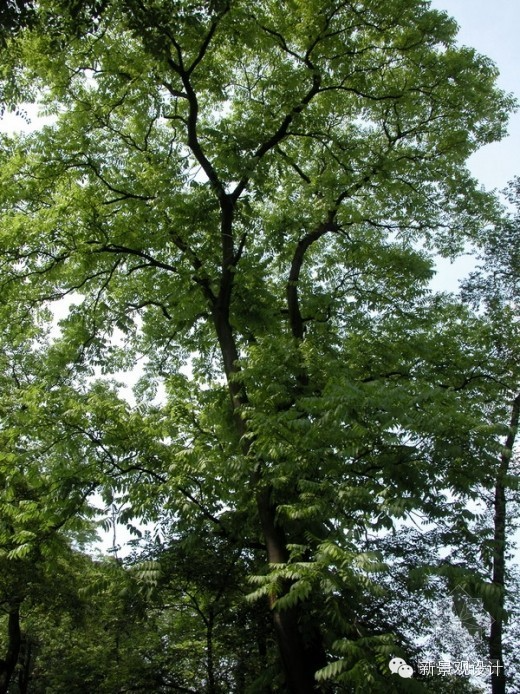
Soapberry, Sapindaceae, genus Sapindaceae
Scientific Name: Sapindus mukurossi Gaertn
Identification points: Deciduous tree, up to 25 meters tall. Branches spread out, twigs glabrous, densely covered with numerous lenticels; winter buds axillary, with 2 pairs of scales on the outside, slightly hairy. Usually even pinnate compound leaves, flowering from June to July. Fruiting from September to October.
Ecological habits : light-loving, slightly shade-tolerant, strong cold-resistance. Not strict on soil, deep-rooted, strong wind resistance. Not tolerant to water and humidity, but can tolerate drought.
Garden use : The trunk is straight, the branches and leaves are wide, and the shade is dense. In winter, the leaves are golden yellow, so it is also called the golden tree. It can be regarded as one of the colorful leaf trees. In October, the fruits are abundant and beautiful. It is an excellent foliage and fruit viewing tree for greening.
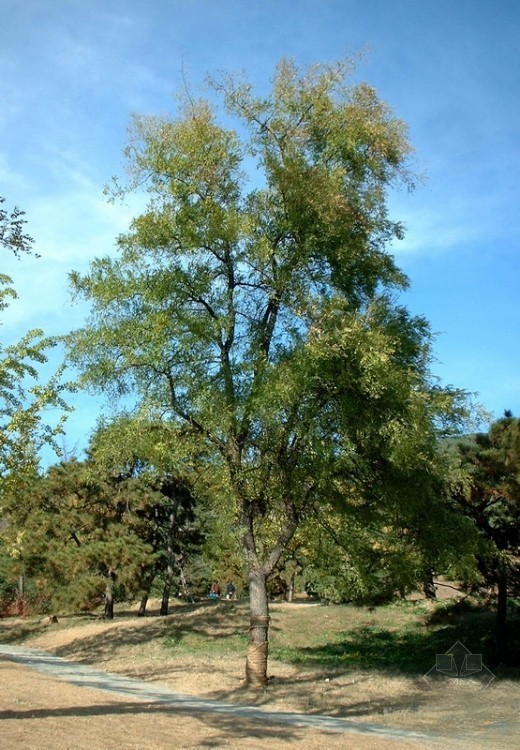
Jujube tree, Rhamnaceae
Scientific name: Zizyphus jujuba
Key points for identification : Deciduous tree, up to 10 meters tall, with an ovate crown. The bark is gray-brown and cracked. The branches are divided into long branches, short branches and deciduous branches. The long branches are reddish brown, zigzag-shaped, smooth, with stipule thorns or inconspicuous stipule thorns; the short branches are alternate on the long branches that are more than two years old; the deciduous branches are slender, without buds, clustered on the short branches, and fall off with the leaves in autumn. The leaves are ovate to ovate-oblong.
Ecological habits: Jujube is relatively drought-resistant and requires little water. It is suitable for growing in poor soil. The tree grows slowly, so the wood is hard and fine, not easy to deform, and is suitable for making carvings.
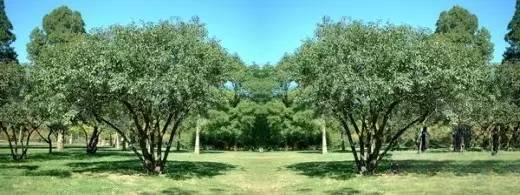
buckthorn
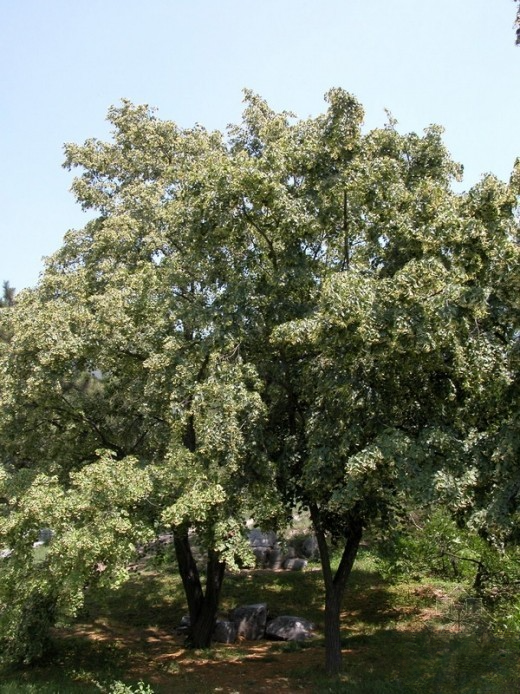
Tilia, Tiliaceae
Scientific name : Tilia mandchurica Rupr.er Maxim.
Identification points : Deciduous tree, up to 20 meters tall, with grayish-white bark. Leaves are alternate, ovate, 8-15 cm long, 7-14 cm wide, with sharp tips, shallowly cordate leaf bases, coarsely serrated leaf margins with long tips, and densely white hairs on the back of leaves. Cymes droop, bracts 5-15 cm long, petals yellow. Fruits are spherical, 5 mm in diameter.
Ecological habits : It likes light and is relatively shade-tolerant. It likes cool and humid climates and deep, fertile, well-drained neutral and slightly acidic soils. It is cold-resistant and has poor stress resistance. It grows poorly in dry and barren soils. It is prone to leaf fall in summer droughts. It is not tolerant to saline-alkali soils and smoke pollution. It has deep roots, well-developed taproots, and is tolerant to pruning. It has few diseases and insect pests.
Garden use : Suitable for planting alone, scattered or in rows in the garden. The leaves are beautiful, the tree is quiet and the shade is thick in summer. The tree is full of yellow flowers and is fragrant. It is a good garden shade tree, street tree, and excellent nectar source tree species. It should be promoted and applied in northern gardens.
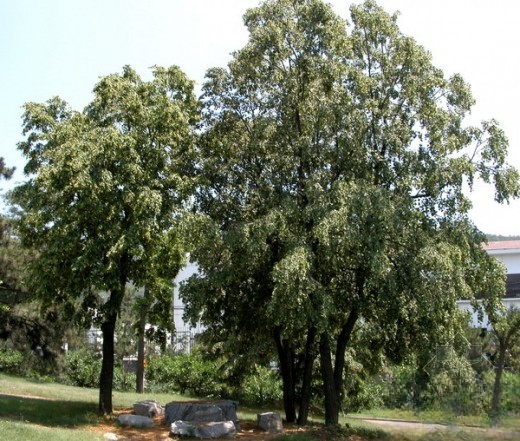
Tilia mongolica, Tiliaceae, Tiliaceae
Scientific Name : Tilia mongolica
Identification points : Deciduous tree or small tree. Some species can reach a breast diameter of more than 1 meter. The bark is fibrous and the plant surface often has star-shaped hairs. The leaves are alternate, ovate or broadly ovate, gradually pointed at the top, heart-shaped or truncated at the base, often asymmetrical. The flowering period is June to July, and the fruiting period is September to November.
Ecological habits : slightly shade-tolerant or light-loving, suitable for deep, fertile, moist soil, can grow in valleys and hillsides. Deep roots, medium growth rate. Strong germination ability.
Garden use : The tree is relatively short and is only suitable for planting upright in parks, gardens and scenic areas. It is not suitable as a street tree.
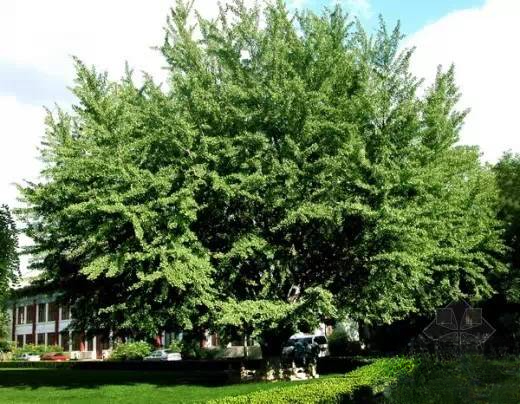
Ginkgo, Ginkgoaceae
Scientific name : Ginkgo biloba, Ginkgo has a long lifespan, with some ancient trees over 3,000 years old. It is suitable for growing in subtropical monsoon areas with relatively favorable water and heat conditions.
Identification points : Large deciduous tree, with a breast diameter of up to 4 meters. The bark of young trees is nearly smooth and light gray, while the bark of large trees is gray-brown with irregular longitudinal cracks. There are long branches and slow-growing short branches. Leaves are alternate, scattered radially on long branches, and clustered in 3 to 5 on short branches. They have slender petioles, fan-shaped, light green on both sides, more or less notched or 2-lobed on the broad top edge, 5 to 8 (~15) cm wide, with many forked and spur-like fine veins. Dioecious, rarely monoecious, cones solitary in the leaf axils of short branches; male cones are catkin-shaped, with many stamens, each with 2 anthers; female cones have long stalks, the end of the stalk is often forked (rarely 3 to 5 forks), and the fork end has an ovule with a disc-shaped receptacle, and often one ovule develops into a developed seed.
Garden use : Ginkgo biloba is tall, straight, graceful, green in spring and summer, golden in late autumn, and an ideal tree species for gardening and roadside. It can be used for gardening, roadside, highway, field forest network, and windbreak. It is listed as one of the four long-lived ornamental tree species (pine, cypress, locust, and ginkgo).
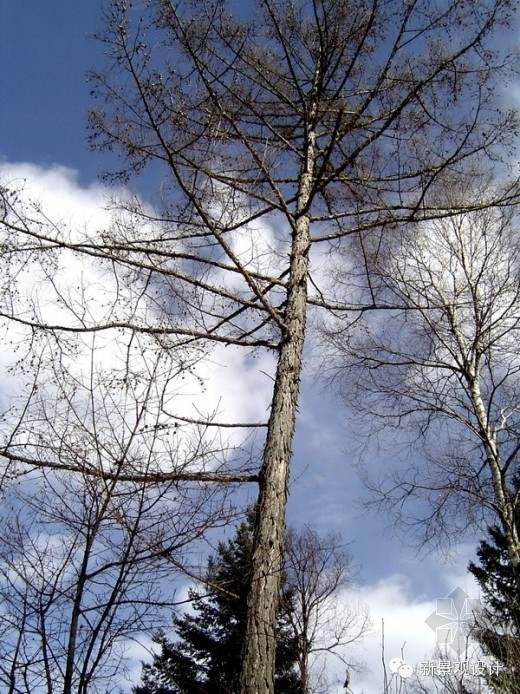
Larix, Pinaceae Larix
Ecological habits: It likes sunlight, has high requirements for water, has strong adaptability, and can grow in peat swamps and extremely dry slopes. It grows best in gently sloping land with good drainage and thick upper layers.
Identification points: Deciduous tree, up to 35 meters tall, with a breast diameter of up to 90 centimeters. The bark is gray, dark gray or gray-brown, with deep furrows, and it cracks longitudinally into flakes and falls off, with purple-red marks; the cross section after breaking is dark brown; the flesh is light flesh-red. The heartwood and sapwood are clearly distinguished. The sapwood is yellowish white with a slight brown tint, and the heartwood is yellowish brown to brownish brown. The annual rings are clearly demarcated. The wood rays are thin. One-year-old branches are slender, about 1 mm in diameter, light yellowish brown or light brownish yellow, glabrous or sparsely hairy, and often have long hairs at the base. Two- and three-year-old branches are brown, grayish brown or gray; short branches are 2-3 mm in diameter, with nearly white long hairs at the top; winter buds are nearly round or oval, with dark brown bud scales and brown eyelashes on the edges. The leaves are oblanceolate linear, flat, 1.3-3 cm long, 0.5-1.0 mm wide, flat on the surface, sometimes with 1 or 2 stomatal lines on each side, the midrib on the back is raised, and there are 2 or 3 stomatal lines on each side. When the cones are mature, the upper seed scales are cup-shaped or elliptical, yellow-brown, light brown or sometimes purple, 1.2-2.5 cm long, 1-2 cm in diameter, and 16-30 seed scales; the middle seed scales are horn-shaped ovate, the back of the scales is hairless and shiny. The bracts are shorter, 1/3-1/2 the length of the seed scales, ovate-lanceolate, and the midrib is extended to an acute tip. The seeds are obliquely rounded ovate, grayish white, with light brown spots, and the wings are about 1 cm long; the lower and middle parts of the seed wings are wide, and the tip is oblique; there are 4-7 cotyledons. The flowering period is May-June, and the cones mature in September-October.
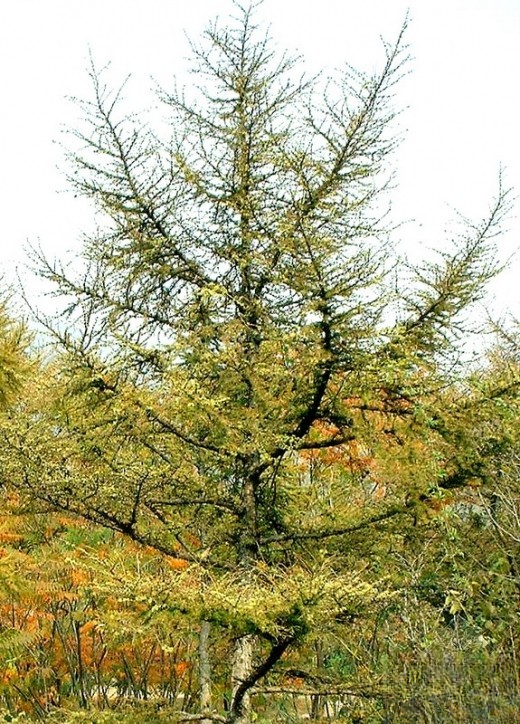
Larix principis-rupprechtii, Pinaceae, Larix olgenus,
Identification points: Deciduous tree, conical crown, dark gray-brown bark with irregular scaly cracks, large branches spread out, small branches not drooping, cones oblong or ovate, about 2--4 cm long, about 2 cm in diameter, 26--45 seed scales, smooth and hairless on the back, edges not recurved, bract scales shorter than seed scales, dark purple; seeds grayish white with brown markings and long wings.
Ecological habits : A strong sun-loving tree, extremely cold-resistant. Strongly adaptable to soil, prefers deep, moist and well-drained acidic or neutral soil. The crown is neatly conical, and the leaves are soft and unrestrained, forming a beautiful landscape. Most suitable for configuration and application in areas with higher altitudes and higher latitudes.
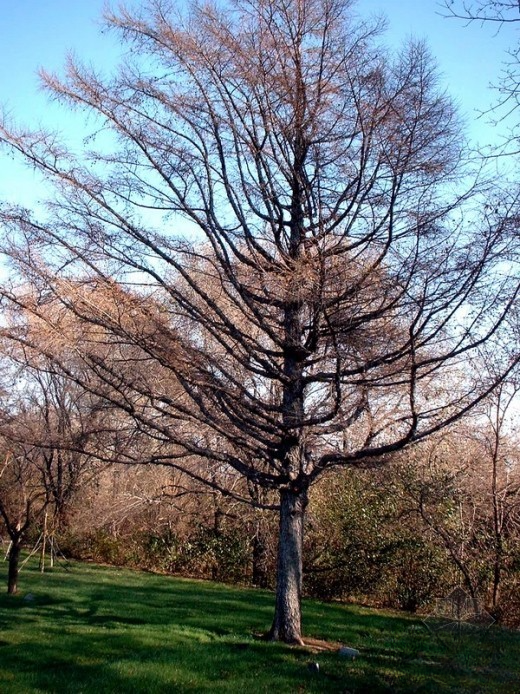
Larix gmelinii, Pinaceae, Larix gmelinii,
Scientific name : Larix olgensis Henry.
Identification points : Deciduous tree, up to 40 meters high, with a spire-shaped crown. Annual branches are light reddish brown or light brown, cones are ovate or ovate, 1.4-1.5 cm in diameter, bracts are not exposed, flowering period is April-May, and fruits mature in mid-August.
Ecological habits : like light, tolerate severe cold, like moisture, have strong adaptability, do not require high soil water and fertilizer conditions, and have a certain degree of drought and water resistance.
Landscape use: Garden shade tree, scenic forest, can be planted in places with sufficient sunshine and less wind damage. It is suitable to be planted with broad-leaved trees or in clusters.
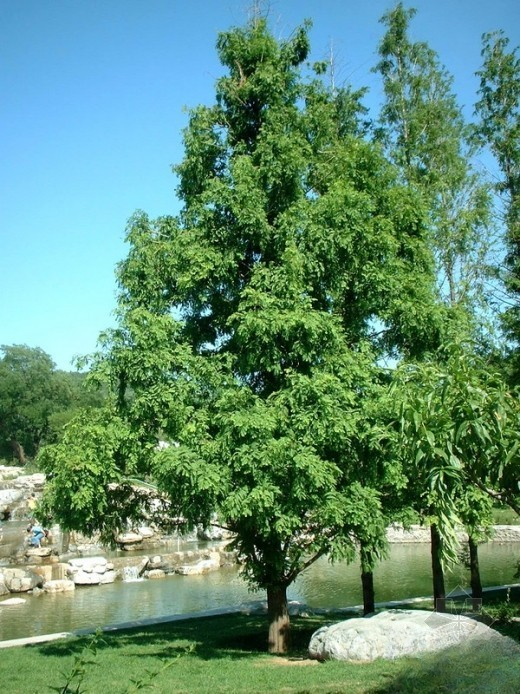
Metasequoia, Taxodium vulgaris,
Scientific name : Metasequoia glyptostroboides Hu et Cheng.
Identification points : Deciduous tree, 35-41.5 meters tall, 1.6-2.4 meters in diameter; blooms in February and fruits mature in November. Light-loving, tolerant of barrenness and drought, purifies the air, grows slowly, and is easy to survive after transplantation. Adapts to temperatures between -8 and 38 degrees Celsius.
Garden use: The trunk of Metasequoia is straight and upright, tall and slender, the crown is conical, the posture is graceful, the leaves are emerald green, the branches and leaves are lush, and the leaves are golden in autumn. It is a famous garden ornamental tree. It likes light and moisture, grows fast, and can be propagated by sowing and cuttings. It is an ideal tree species for garden greening. Metasequoia can be planted alone, in rows or in groups in parks, courtyards, lawns, and green spaces; it can also be planted in patches to create landscape forests, and is suitable for evergreen ground cover plants; it can also be planted in front of buildings or used as a street tree, and the effect is good. It has strong adaptability and grows very quickly. In its young stage, it can grow more than 1 meter per year. It is a good tree species for plain greening and barren mountain afforestation in subtropical areas, and can be used for fast-growing materials.
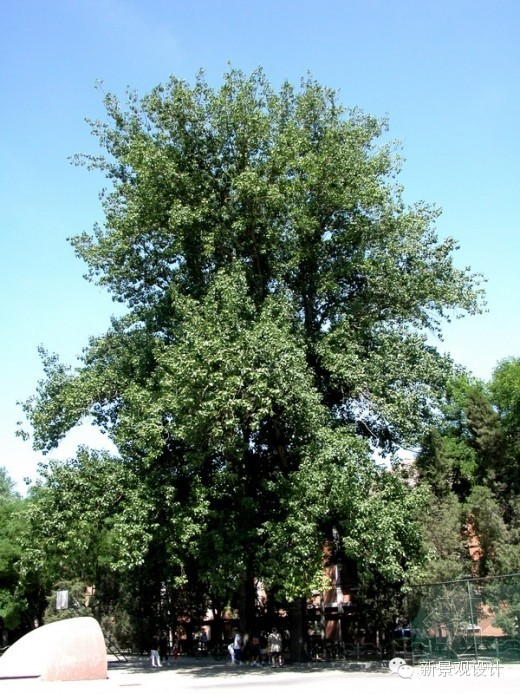
Populus tomentosa, Salicaceae
Scientific Name : Populus tomentosa Carr
Identification points : Tree, up to 25 meters tall. Bark is grayish white, dark gray when old, with longitudinal cracks. Flowering period is March. Fruiting period is April.
Ecological habits: Strong sun-loving tree species. Prefers cool and humid climates, and is susceptible to diseases in warm, rainy climates. Not very demanding on soil, prefers deep, fertile, sandy loam, is not tolerant to excessive drought, and is slightly tolerant to alkali.
Garden use : Populus tomentosa is tall and straight, majestic, with large leaves and dense shade. It grows fast and low, has strong adaptability and a long life. It is an excellent greening tree species in urban and rural areas and industrial and mining areas. It is also often used as a street tree, a garden tree, a garden shade tree or to create a protective forest for building protection; it can be planted alone, in clusters, or in groups around buildings, lawns, squares, and waterfronts; it can be planted in rows or in groups around streets, highways, school playgrounds, factories, and pastures.
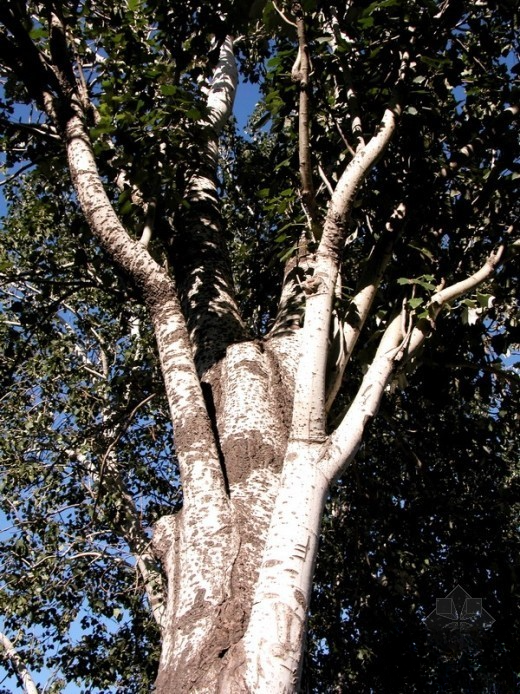
Populus alba, Salicaceae
Scientific Name : Populus alba
Identification points : 15-30 meters tall, with a broad crown; white to grayish white bark, often rough at the base. Branches covered with white velvet. Flowering period: April to May, fruiting period: May to June.
Ecological habits: It likes light and cannot tolerate shade. It can tolerate severe cold and has no frost damage at -40 degrees. It can tolerate drought but cannot tolerate humidity and heat. It is easy to be infected with diseases and insect pests when cultivated in the south, and its trunk is often curved and shrub-like.
Garden use : The tree is tall, and its silvery white leaves sway in the breeze and have a special flickering effect under the sun. It can be used as a garden shade tree, a street tree, or planted in clusters on lawns. It can also be used to fix sand, conserve soil, protect rocks and embankments, and afforestation in barren sand.
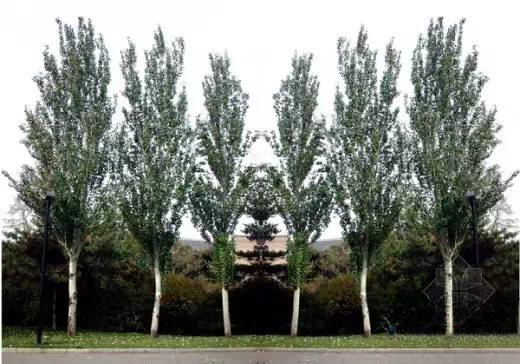
Xinjiang Poplar, Salicaceae Populus
Scientific name : P.bolleana
Identification points : Tree, up to 30m tall; branches upright, forming a cylindrical crown. Bark gray-green, gray-white when old, smooth, rarely cracked. Single leaves alternate. Dioecious, catkins, positive, resistant to atmospheric drought and saline soil, deep-rooted, strong wind resistance.
Ecological habits : It likes partial shade, warm and humid climate and fertile neutral and slightly acidic soil, and is not very cold-resistant.
Garden use : Xinjiang poplar has beautiful shape and leaves, and is a good tree species for urban greening or roadside planting. It is suitable for planting alone or in groups on lawns, in front of courtyards, or on roadsides and embellishing rocks. It can also be used as a hedge and basic planting material.
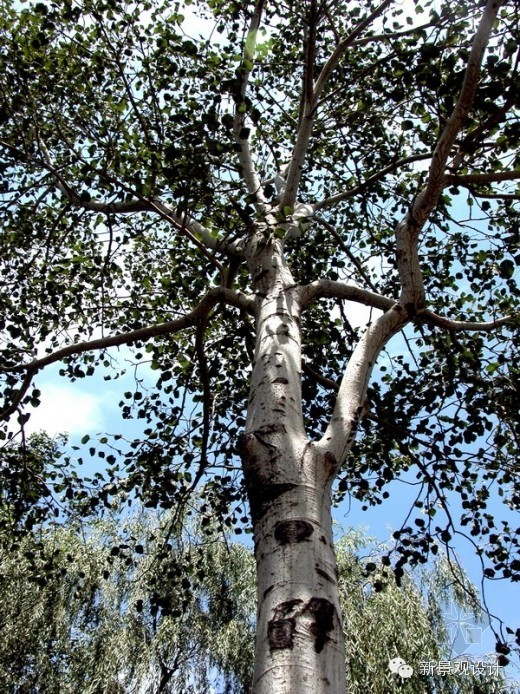
Hebei Populus, Salicaceae Populus
Scientific Name : Populus hopeiensis Hu et Chow
Identification points: Up to 30 meters tall. Bark is yellowish green to grayish white and smooth; crown is round and large. Branchlets are cylindrical, grayish brown, hairless, yellowish brown with soft hairs when young. Flowering period is April, fruiting period is May to June.
Ecological habits : cold-resistant, drought-resistant, likes moisture, but not waterlogged; often grows poorly on hilltops and south-facing slopes that lack water. Fast-growing, naturally grows on sloping loess. 6-year-old height is 8.8 meters, breast diameter is 7.1 cm, deep roots, well-developed lateral roots, strong germination, and resistant to wind and sand.
Garden use : The bark of Hebei poplar is white and clean, the crown is round, the branches are thin and soft, stretching flat or even slightly drooping, and the lively leaves with round and wavy edges form a delicate and soft feature. It is a beautiful garden shade tree, street tree and landscape tree, suitable for single planting or clump planting on lawns and banks. It can be used as a windbreak and sand fixation afforestation species in the Loess Plateau area of the northwest.
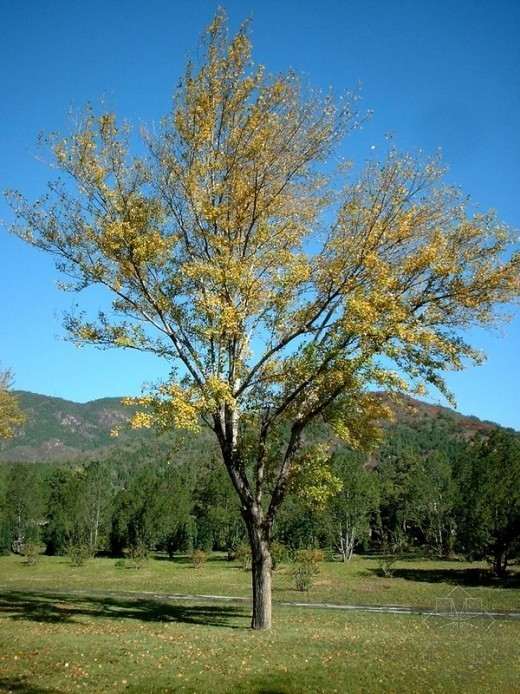
Populus, Salicaceae
Scientific Name : Populus davidiana
Identification points : Up to 20 meters tall, with a round or nearly round crown, smooth bark, light green or light gray, with dark gray at the base of old trees; leaf buds slightly colloid. Flowering and fruiting period: April to June.
Ecological habits : A strong sun-loving tree species, resistant to cold, drought and barren soil. It can grow in slightly acidic to neutral soil and is suitable for well-drained and fertile soil below the mountain.
Garden use : It is a beautiful garden shade tree, street tree and landscape tree. It is suitable for planting alone or in groups on lawns and banks. It can be used as a windbreak and sand fixation afforestation species in the Loess Plateau area of the northwest.
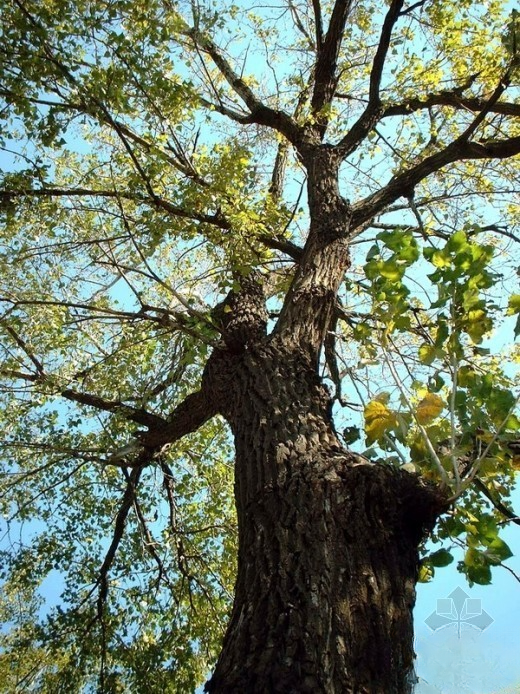
Populus spp., Salicaceae
Scientific Name : Populus canadensis Moench
Identification points: Deciduous tree, more than 30 meters high. Straight trunk, thick bark, deep grooves, dark gray at the bottom, brown-gray at the top, large branches slightly tilted upward, ovate crown; budding branches and seedling stems have obvious edges and corners, twigs are cylindrical, slightly angular, glabrous, and sparsely covered with short soft hairs. Flowering period is April, and fruiting period is May-June.
Ecological habits : likes warm and humid climate, can tolerate thin and slightly alkaline soil; fast growing, 4 years old.
Garden use : Canadian poplar is tall, with a broad crown, large and shiny leaves, and dense shade in summer, making it very suitable for use as a street tree, garden shade tree, and shelterbelt. At the same time, it is also a good tree species for greening industrial and mining areas and "around" greening. Due to its strong adaptability and fast growth, it has become one of the most common greening tree species in North China and the Jianghuai Plain.
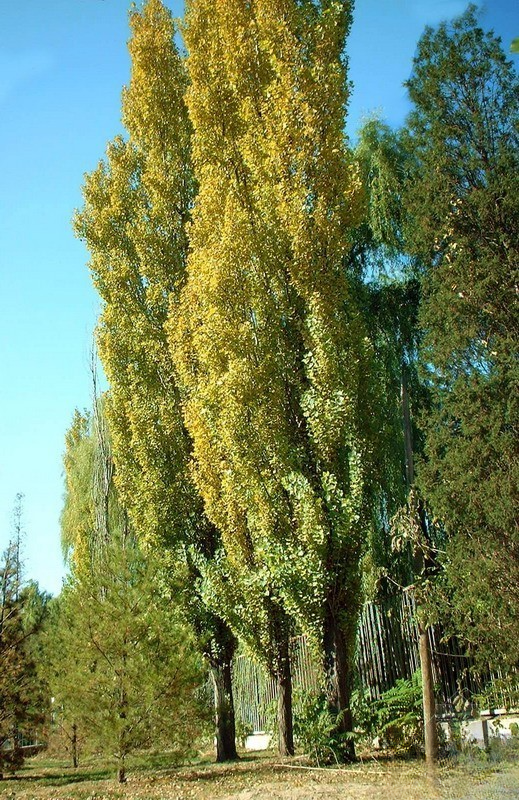
Populus serrata, Salicaceae
Scientific name : Populus nigra var.italica
Identification points : Deciduous tree, up to 30m tall. Dark grey-brown bark, with cracks when old; cylindrical crown. Buds are long oval, with long and gradually pointed tips, light red, and rich in stickiness. Flowering period is April, and fruiting period is May.
Ecological habits : It likes light, is cold-resistant, and can tolerate dry and cold climates. It is prone to diseases and insect pests in hot and humid climates. It is slightly tolerant to saline-alkali and waterlogging, and avoids low-lying waterlogging and dry and heavy soil. It has poor ability to resist diseases and insect pests. It grows fast but has a short lifespan.
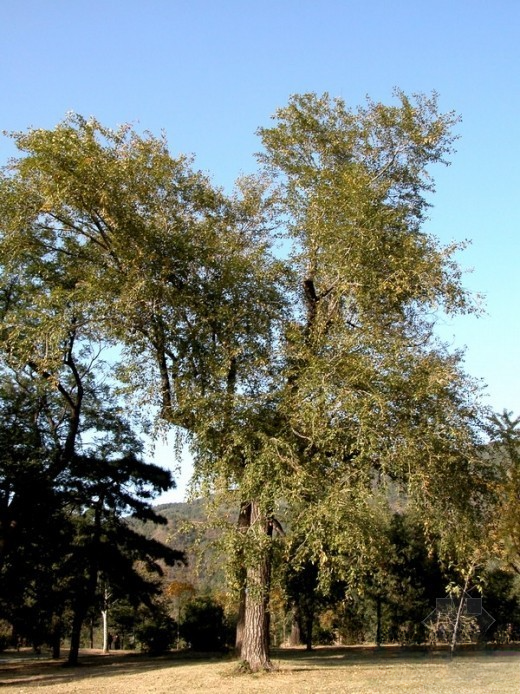
Populus microphylla, Salicaceae
Scientific name : PopulussimoniiCarr.
Identification points : Deciduous tree, 15-25m tall, with a breast diameter of more than 1m. The bark of young trees is gray-green and dark gray with longitudinal grooves. The crown is oval. The flowering period is April and the fruiting period is late May.
Ecological habits : It likes light and moisture, is resistant to barrenness, drought, and cold, and has strong adaptability. It can grow in ravines, river beaches, plains, terraces, and short-term waterlogging areas. It grows quickly and has strong germination ability, but its life span is short.
Garden use : beautiful tree shape, beautiful leaves, fast growth, strong adaptability, is a good choice for greening around wetlands. But the life span is short, generally 30 years into the aging stage.
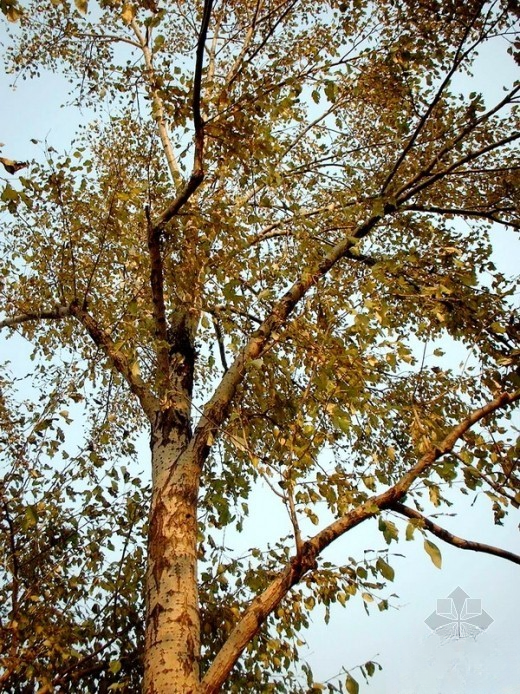
Populus cathayana, Salicaceae
Scientific name : P. cathayana
Identification points : Deciduous tree, up to 30 meters tall. The crown is broadly oval. The bark is gray-green and smooth. The flowering period is April to May; the fruit ripening period is May to June.
Ecological habits : It likes light, warm and cool climate, and can tolerate severe cold. It is suitable for growing in deep, fertile, moist, well-drained sandy loam and riverbed sand. It avoids low-lying waterlogging, but has a well-developed root system, is drought-resistant, not salt-alkali-tolerant, grows fast, and has strong sprouting ability.
Garden use : With a full crown and beautiful bark, it is an important shade tree and street tree in the high-altitude desert areas of the northwest. It can also be used for river beach greening, shelterbelts, embankment protection and timber forests. It is often planted with seabuckthorn to increase its growth. Populus cathayana leaves out very early. In Beijing, it sprouts and leaves in mid-March. The new leaves are bright green, making people feel the breath of spring as soon as possible.
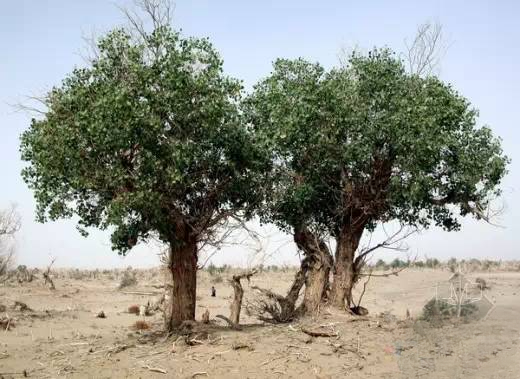
Populus euphratica, Salicaceae
Scientific Name : Populus euphratica
Identification points : Up to 30 meters tall, 1.5 meters in diameter; bark gray-brown with irregular longitudinal cracks. Flowering period is May, fruiting period is June to July.
Ecological habits : It likes light, warm and cool climate, and can tolerate severe cold. It is suitable for growing in deep, fertile, moist, well-drained sandy loam and riverbed sand. It avoids low-lying waterlogging, but has a well-developed root system, is drought-resistant, not salt-alkali-tolerant, grows fast, and has strong sprouting ability.
Garden use : Populus euphratica is also known as the 'Guardian of the Desert'. It is a magical plant. For thousands of years, it has been resolutely guarding the border desert and watching over the wind and sand.

Salix matsudana, Salicaceae
Scientific name : hankow willow
Identification points : Up to 18 meters tall. Dark gray-black bark, longitudinally cracked, branches erect or obliquely spreading, brownish yellow-green, later turning brown, glabrous, young branches hairy; buds brown, slightly hairy. Leaves lanceolate
Ecological habits : It likes light-loving trees, is relatively cold-resistant and drought-resistant. It likes moist, well-drained and ventilated sandy loam, but it is easy to rot roots, cause dead branches and even die in clay or low-lying wetlands with long-term water accumulation.
Garden use : With soft branches and full crown, Salix matsudana is a common garden shade tree and roadside tree in the north. It is often planted on the banks of rivers and lakes or planted alone on lawns or on both sides of buildings. It is also used as a road tree, shelterbelt, sandy wasteland afforestation, and rural "four sides" greening. It is an early spring dense source tree species.
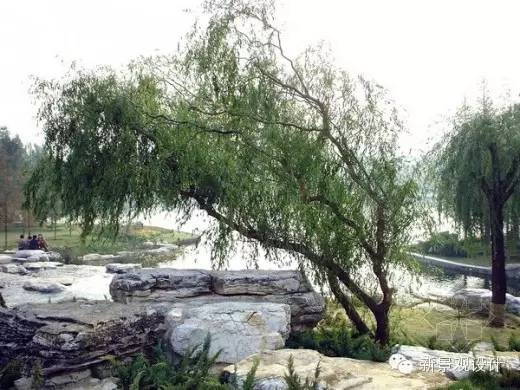
Dragon claw willow, Salicaceae Salix
Scientific Name : Salix matsudana f. tortuosa
Identification points : Deciduous shrub or small tree, up to 3 meters in height, with green or green-brown twigs, irregularly twisted; leaves are alternate, linear-lanceolate, with finely serrated edges, pink-green on the back, and the entire leaf is wavy; unisexual, with racemes and capsules.
Ecological habits : It likes humidity, moist loam is the best soil for cultivation, followed by sandy loam. Sufficient sunlight is required.
Garden use : The branches are twisted, especially suitable for winter gardening, and also suitable for planting in green spaces or along roads. The leaves and branches are often used in flower arrangements.
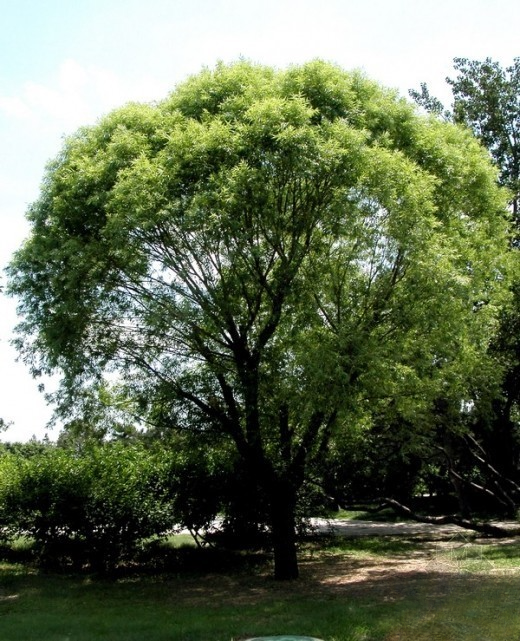
Mantou willow, Salicaceae
学名:Salix matsudana cv. Umbraculifera Rehd.Salix matsudana ‘Umbraculifera’
Identification points : deciduous tree, dense branches, slightly neat ends, semi-circular crown, shaped like a steamed bun
Ecological habits : Positive, likes warm and cool climate, resistant to pollution, fast-growing, cold-resistant, moisture-resistant, and drought-resistant. Poor growth in consolidation, heavy clay soil and heavy saline-alkali land. Not shade-resistant, likes water and humidity and is drought-resistant.
Garden uses: Garden shade tree, street tree, bank protection tree, often used as an ornamental street tree, can be planted alone, in groups or in rows.
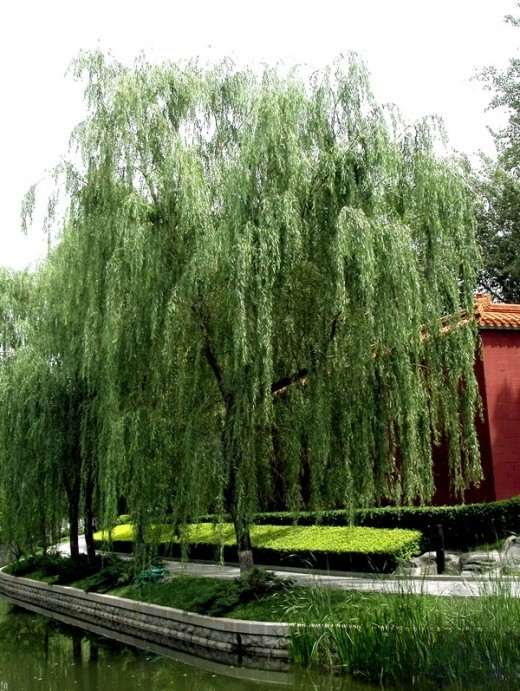
Weeping willow, Salicaceae
Scientific name : Salix babylonica
Identification points : Deciduous tree, up to 18m in height; crown is inverted broad ovate. Twigs are slender, very soft, drooping, 1.5~3 meters long.
Ecological habits : Positive, likes warm and cool climate, resistant to pollution, fast-growing, cold-resistant, moisture-resistant, and drought-resistant. Poor growth in consolidation, heavy clay soil and heavy saline-alkali land. Not shade-resistant, likes water and humidity and is drought-resistant.
Garden use : The branches of weeping willow are slender, soft and drooping, dancing in the wind, and graceful and unrestrained. In garden greening, it is widely used for riverside and lakeside greening. Its soft branches touch the water, which is unique and has been an important garden ornamental tree since ancient times.